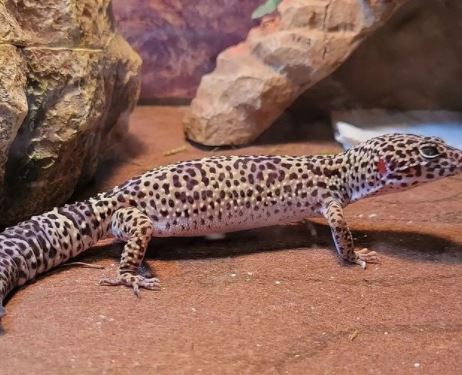How deep should leopard gecko substrate be? The deepness of the substrate in a leopard gecko tank can have a significant impact on your pet’s health.
In this blog post, we will discuss why substrate depth is important and what you should consider when determining how deep it should be.
We also include some recommendations about the best type of substrate to use for leopard geckos. Let’s get started!
Related Posts:
- Top 7 Best Leopard Gecko Starter Kit for Easy Setup
- What Tank Size Does a Leopard Gecko Need?
- How Often Should You Mist a Leopard Gecko Tank?
- Why Is My Leopard Gecko Hiding and Not Eating?
- Are Leopard Geckos Sensitive to Light?
How Deep Should Leopard Gecko Substrate Be?
How deep should leopard gecko substrate be?
Leopard geckos need 3″ of the substrate to live in. Zoo Med ReptiSand is a good kind. It is made from natural, very fine quartz desert sand.
There are many different substrates that you can use in a leopard gecko terrarium, but they differ by one or more characteristics:
- Price/performance ratio
- Hygiene question (how easy to remove the substrate from the terrarium after some time?)
- Easiness in caring for (does it make cleaning harder or not?)
- Availability (what types are available in your country?)
- Ease of handling (how easy is it to spot feces or possible impaction?)
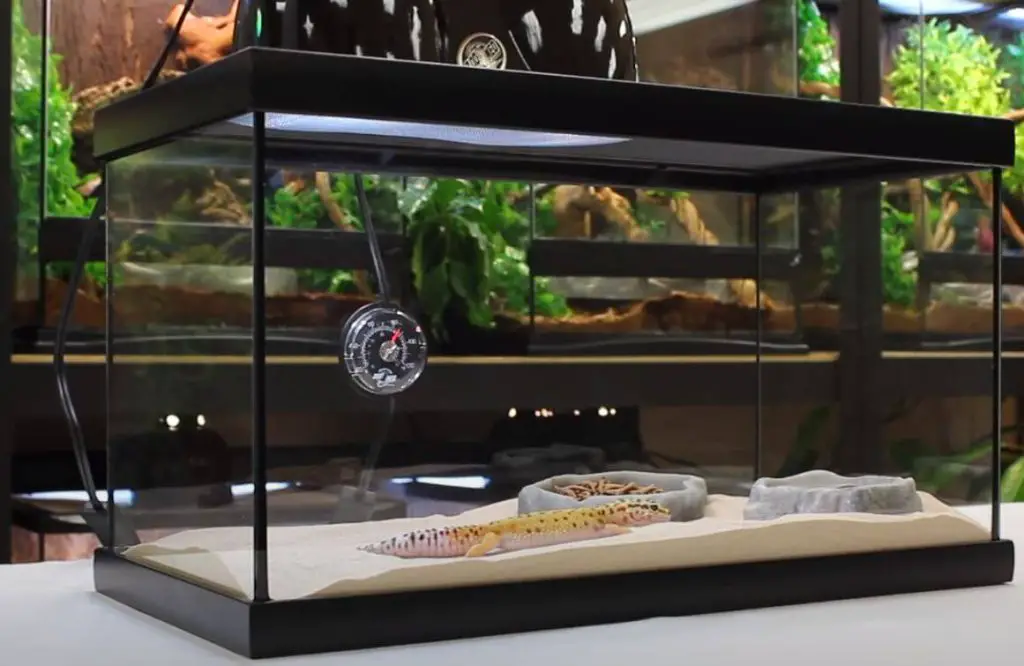
The substrate will be the base of your leopard gecko terrarium. It will carry weight for large parts of the cage, so it needs to be durable enough to hold this pressure without collapsing.
Another important aspect is that the substrate should not carry any risk to the inhabitants.
This means that you should avoid using things like wood chips or anything with a very rough surface as it can cause injuries, especially on humid areas around their bodies, such as toes and tail.
Leopard geckos are known for having dry skin, so if there is an area where their skin becomes moist because they crawl over it frequently, this could cause problems.
One thing to keep in mind is that leopard geckos like to take dust baths. They will roll around in the substrate and spread it all over their bodies. This can lead to a problem if you use sand. It gets everywhere!
On the other hand, the dust from sand stays on the body for quite some time, so when your gecko takes its next bath, there won’t be any loose particles anymore.
The same applies to very fine ground coconut fibers or alfalfa pellets. It’s almost impossible to get rid of them from crevices in their bodies after a while.
This means you have to choose your substrate carefully!
The best options are substrates that are easy to spot clean and don’t carry any risk for impaction.
The substrate you choose will be placed in the terrarium after setting up all other parts like rocks, wood, water bowls, etc.
During this process, your gecko is locked out of its home until everything is done. This means that it would never encounter any of the substrates directly before it has time to adjust itself.
While leopard geckos can more or less handle large changes in their cages (like rearranging the decoration), they absolutely need some time (at least a day) to acclimate themselves after something like adding new substrate.
So make sure you do this last if possible!
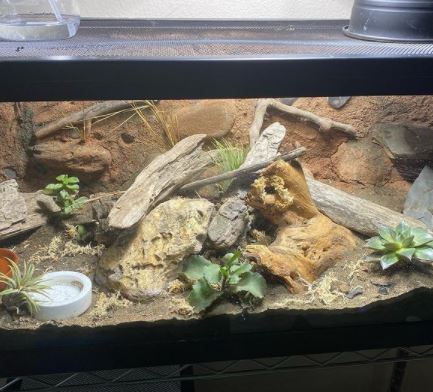
How to Choose the Right Substrate for Your Leopard Gecko?
You already know the answer to the question, “How deep should leopard gecko substrate be?” Now, how can you choose the right substrate for them?
What we have just written is a general rule.
We see that there are many people who would never use sand because they heard it can lead to impaction, but at the same time fill their leopard gecko terrarium with coconut fibers or alfalfa pellets because they don’t carry this risk despite the fact that these two substrates cannot be spot-cleaned easily and present a huge dust issue.
There even exist people who mix different substrates such as coco peat and alfalfa pellets.
In an ideal world, you should always go for substrate types you both like and trust. But if you want to choose one or the other, make sure that your final decision is not solely based on the information we wrote here.
There are many exceptions to the rule, so do your own research before choosing a substrate. In case of doubt, ask an expert for help!
Below, we will introduce you to different types of substrates and explain their pros and cons.
1. Coconut Fibers (coir)
Coconut fiber is very popular in terrarium construction. It’s made from the husk of coconuts, which makes it quite natural and gives it some advantages compared to alternatives like sand or reptile carpet.
However, this is also its biggest problem: There is no “one type” of coconut fiber but many different qualities on the market, which differ greatly in hardness and durability.
Even worse, there exist special ones called “reptile carpet” (coir) that are made for reptiles, but these are even more artificial than some other alternatives like reptile carpet.
Pros:
- Natural
- Easy to spot-clean (dampen, let dry completely, and replace)
- Doesn’t cause impaction risk
Cons:
- Carries an enormous dust problem (dust easily becomes airborne)
- Sticks to food items like crickets, making it hard to feed your gecko properly
- Not all types are equally durable/hard
- Some can be too soft or have sharp edges, which could harm your leopard gecko
Always use a coarse type of coconut fiber that has long durability if you want to go with this substrate type. Never use a fine one!
2. Sand
Sand can be a great substrate if you know how to handle it properly.
On the other hand, there is a high risk of impaction if it’s not used correctly, so this is definitely not something for beginners.
Pros:
- Inert
- Can’t cause impaction
- Looks natural
Cons:
- Carries an enormous dust problem (dust easily becomes airborne)
- You have to spot clean daily, which can become a hassle in larger terrariums
Use large-grained sand that doesn’t stick to food items and is very easy to spot clean without losing too many particles in the process.
As a general rule of thumb, the smaller your gecko, the coarser your sand should be.
If you can’t find any large-grained sand, you should use coconut fiber instead!
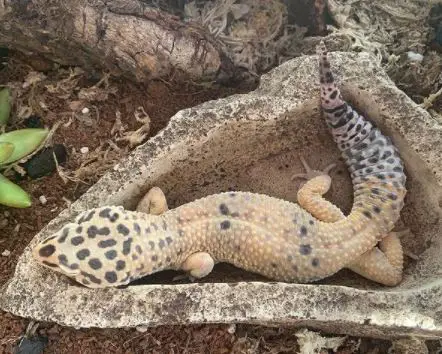
3. Reptile Carpet (PVC)
Reptile carpet is made from PVC.
It is very even and smooth, which makes it easy to clean but it cannot be spot-cleaned since water can penetrate the material if it is not dry for 24 hours.
Some types are even toxic for your leopard gecko, so do some research before buying a reptile carpet or ask an expert for advice on which type he/she would recommend.
Pros:
- Inert
- Easy to spot clean (dampen thoroughly until wet completely, let dry completely, and replace)
- Doesn’t carry impaction risk
Cons:
- Tacky food items like crickets, making it hard to feed your gecko properly
- Not all types are equally durable/hard
- Some can be too soft or have sharp edges which could harm your leopard gecko
Always use a high-quality reptile carpet that has an even color and is very easy to spot-clean without losing too many particles in the process.
As a general rule of thumb, the smaller your gecko, the coarser your sand should be.
If you can’t find any large-grained sand, you should use coconut fiber instead!
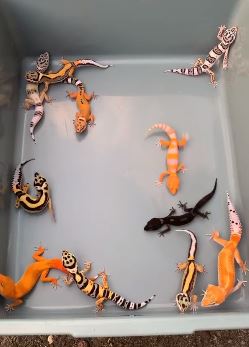
4. Wood Chips
Wood chips aren’t really a good substrate choice because they can be abrasive and also retain humidity.
Pros:
- Inert
Cons:
- Retains humidity
- Carries an enormous dust problem (dust easily becomes airborne)
- Not always easy to find which type of wood is used for what you want to buy (pine? aspen?)
If you do use this type of substrate, make sure it’s not too coarse, and never use cedar or other types of pine!
Cedar is toxic to reptiles in general, and when using any type of pine, the risk of your gecko getting impacted increases dramatically even though most types don’t cause problems with their droppings like cedar does.
Also, only use plain “wood” chips. Not all types of wood chips come from a safe type of wood! Some contain other additives to make them last longer, which can be very harmful if ingested.
5. Calci Sand
Calcium sand contains quartz, so it is inert. It has a tendency to stick to food items, though, and is hard to spot-clean without losing particles in the process.
However, it doesn’t carry an impaction risk like similar substrate types do because it’s even and soft but also quite small in size.
Pros:
- Inert
- Easy to spot clean (dampen thoroughly until wet completely, let dry completely, and replace)
Cons:
- Carries an enormous dust problem (dust easily becomes airborne)
Only use this type of substrate if you can keep a very close eye on your gecko since it’s so easy to ingest.
Furthermore, do not moisten the substrate before replacing it! Dust particles are only one potential impaction risk with this type of substrate.
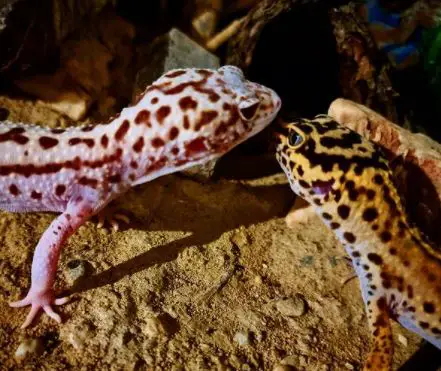
3 DIY Leopard Gecko Substrate Recipes
1. Dirt and Sand Mixture
Ingredients:
- One bag of premixed playground sand (sifted)
- Two big handfuls of topsoil
- One big handful of peat moss
- One big handful of coconut fiber/coir or whatever you prefer to call it
You can use less if you want a lighter substrate, but I like it nice and weighty so the geckos don’t poof it around as much. Plus, some people say it aids in preventing bloat problems.
Note that this mixture doesn’t work in humid environments. Please see the Sand Substrate Mixture below for a more accurate ingredients list based on your climate zone.
Procedure:
Mix all ingredients together in a large tub or trashcan. Sift out all big pieces so you are left with sand, peat moss, and coir.
2. Sand Substrate Mixture
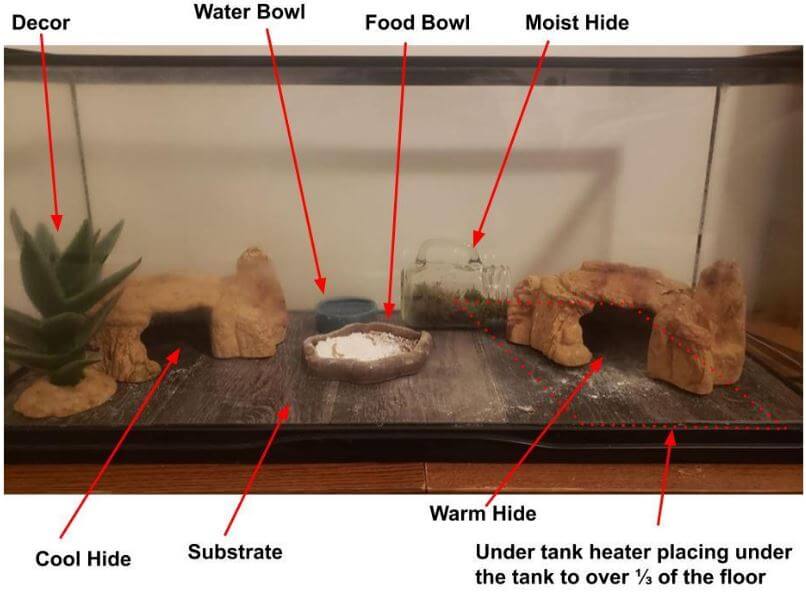
Ingredients:
- Four parts sand (all sizes)
- One part topsoil
- One part peat moss
- One part chopped-up sphagnum moss
- One cup of hydrated lime for every two gallons of soil mix to lower pH
You can also use horticultural/agricultural perlite instead of the sphagnum moss if you wish but I’ve found it results in a much lighter substrate that doesn’t hold together as well.
Plus, it floats on water, so make sure you have very dry geckos before you use this. Note that this mixture works in humid environments.
Procedure:
Mix all ingredients together in a large tub or trashcan. Sift out all the big pieces so you are left with sand, peat moss, and coir.
You can steam the hydrated lime to kill any possible insects/pests that may be living inside of it beforehand if you wish.
I don’t because I prefer not to handle anything more than necessary, but there’s no harm in doing so as long as you make sure to wear gloves and wash your hands thoroughly after handling hydrated lime (use vinegar).
3. Coconut Fiber Substrate Mixture
Ingredients:
- One part sand
- One part topsoil
- One part peat moss
- Three parts coconut fiber
Procedure:
Mix all ingredients together in a large tub or trashcan. Sift out all the big pieces so you are left with sand, peat moss, and coir.
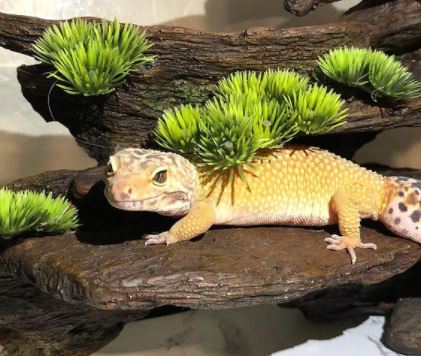
Is Reptile Carpet Safe for Leopard Geckos?
Reptile carpet is not only used for leopard geckos but it can be used in any reptile tank.
It has lots of benefits to it like easy clean up. If your pet does end up urinating on the turf, then you simply pick up the wet area and throw it away or wash it with lukewarm water and put some laundry soap in with it.
Now, you might be thinking, “What about my gecko crawling around on this wet dirty terrain?” Don’t worry!
Once dry, I guarantee that there will be no trace of any sort of urine left behind at all.
Another reason why people get this type of flooring is that they tend to keep their house cleaner. When using tiles or wood flooring, their pets will end up urinating or defecating a lot more often.
We can all agree that this is not good for any of us to see, especially if you do have children.
It could damage their mental well-being as they get older, so why not use a reptile carpet that allows your leopard gecko to roam around with no chest pain from the wood or tiles?
The only downside to a reptile carpet is, if it gets wet, then it can be an absolute nightmare to clean up and will need a few days for it to dry out.
The reason why it’s safe even when it’s wet is that reptiles don’t generally drink much water, so they will hardly ever urinate but very rarely at that!
Another reason why people buy the reptile carpet is that it looks a lot better in their tank and allows for more natural habitat.
Now, the only reason why I said that it’s not recommended to use a reptile carpet in your leopard gecko’s tank is that they can still swallow some of the fibers, which may cause them to get sick or give them diarrhea.
Also, if your pet does manage to eat any part of this flooring, then there’s nothing you can do to help it and it’s bound to die because we all know that we can just cut out chunks from our pet’s stomach.
Other than that, yes, I would recommend the majority of people to use a reptile carpet for their tanks and I’m sure you will be very pleased with how everything turns out!
Conclusion
How deep should leopard gecko substrate be? The substrate should be at least 3 inches deep.
A suitable substrate helps maintain proper humidity levels, provides texture for gripping and shedding, and offers a comfortable surface for movement and burrowing.
It also supports the growth of microorganisms that aid in waste decomposition.
Choosing an appropriate substrate is important for leopard geckos to prevent ingestion, impaction, and respiratory issues.
That said, keep in mind how deep leopard gecko substrate should be when working on it!
Key points for how deep the substrate should be for a leopard gecko:
Choosing the right substrate depth for your leopard gecko’s enclosure is crucial for their well-being. Here’s a comprehensive guide to help you determine the ideal substrate depth:
1. Substrate Types:
- Leopard geckos can be kept on various substrates, including paper towels, reptile carpet, tile, or loose substrates like eco earth, coconut coir, or calcium sand.
2. Age and Size of Your Leopard Gecko:
- Young leopard geckos may have difficulty maneuvering in deep substrates, so it’s crucial to consider their age and size.
- For hatchlings and juveniles, opt for shallower substrates (around 1/2 to 1 inch).
- Adult leopard geckos can handle slightly deeper substrates.
3. Shallow vs. Deep Substrates:
- Shallow Substrate (1/2 to 1 inch): This is suitable for easy cleaning and for young or small geckos.
- Deep Substrate (around 2 to 3 inches): This allows for more natural burrowing behavior in adult geckos.
4. Importance of Burrowing:
- Leopard geckos are known for their burrowing behavior, which helps them regulate their body temperature and seek shelter.
- A deeper substrate allows your gecko to exhibit this natural behavior, promoting mental and physical stimulation.
5. Heating and Hiding:
- Consider the location of your heating elements and hiding spots when determining substrate depth.
- Ensure that heating elements like under-tank heaters are in direct contact with the enclosure floor rather than buried deep in the substrate.
6. Spot Cleaning:
- In shallow substrates, spot cleaning is more manageable, as waste is closer to the surface.
- Deep substrates require more effort when it comes to waste removal.
7. Health and Hygiene:
- Loose substrates like calcium sand can be ingested during feeding or while exploring. It’s essential to monitor your gecko to prevent impaction.
8. Substrate Depth for Breeding:
- When breeding leopard geckos, provide a laying box with deeper substrate (around 4 inches) to accommodate egg laying.
9. Substrate Depth Based on Behavior:
- Observe your leopard gecko’s behavior. If it appears stressed or has difficulty moving in deep substrate, consider reducing the depth.
10. Experiment and Adjust:
- It’s essential to be flexible and willing to adjust the substrate depth based on your individual gecko’s needs and preferences.
Safety Precautions:
- Ensure the substrate is free from sharp objects, rocks, or foreign materials that may harm your gecko.
- Maintain a clean and hygienic enclosure to prevent the growth of harmful bacteria or mold in the substrate.
Conclusion:
Determining the ideal substrate depth for your leopard gecko is a balance between their age, size, natural behavior, and health considerations. By observing your gecko’s preferences and adjusting the substrate depth accordingly, you can create a safe and stimulating environment that supports their overall well-being. Always prioritize your gecko’s comfort and health when making substrate decisions.

